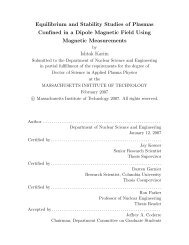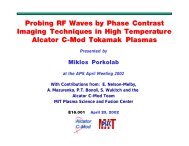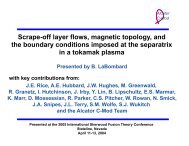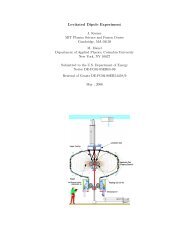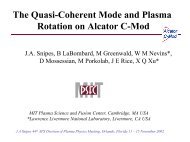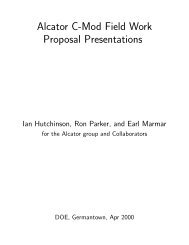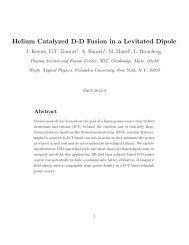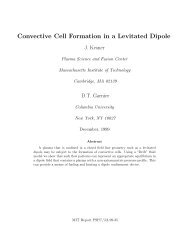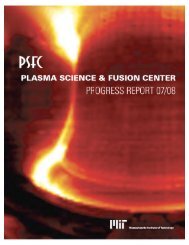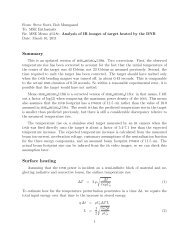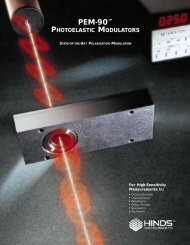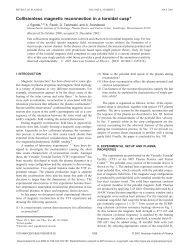Download a copy of the latest PSFC Progress Report - Plasma ...
Download a copy of the latest PSFC Progress Report - Plasma ...
Download a copy of the latest PSFC Progress Report - Plasma ...
Create successful ePaper yourself
Turn your PDF publications into a flip-book with our unique Google optimized e-Paper software.
Background<br />
The Physics Research Division, headed by<br />
Pr<strong>of</strong>essor Miklos Porkolab, seeks to improve<br />
our <strong>the</strong>oretical and experimental understanding<br />
<strong>of</strong> plasma physics and fusion science.<br />
This Division develops basic plasma physics experiments,<br />
new confinement concepts, novel<br />
plasma diagnostics, and is <strong>the</strong> home <strong>of</strong> a strong<br />
basic and applied plasma <strong>the</strong>ory and computations<br />
program. Members <strong>of</strong> <strong>the</strong> Physics Research<br />
Division include <strong>the</strong>oretical and experimental<br />
plasma physicists, faculty members, graduate and<br />
undergraduate students and visiting collaborators,<br />
all working toge<strong>the</strong>r to better understand<br />
plasmas and to extend <strong>the</strong>ir uses.<br />
Recent Research Activities<br />
Fusion Theory and Computation<br />
The <strong>the</strong>ory effort, led by Senior Research Scientist<br />
Dr. Peter Catto, focuses on basic and applied fusion<br />
plasma <strong>the</strong>ory research. It supports Alcator C-<br />
Mod and o<strong>the</strong>r tokamak experiments worldwide,<br />
<strong>the</strong> Levitated Dipole Experiment (LDX), and <strong>the</strong><br />
international stellarator program. In support <strong>of</strong><br />
<strong>the</strong>se efforts, <strong>PSFC</strong> <strong>the</strong>orists are developing improved<br />
analytical and numerical models to better<br />
describe plasma phenomena, both in <strong>the</strong> laboratory<br />
and in nature. In addition to basic plasma<br />
<strong>the</strong>ory, research on radio-frequency heating and<br />
current drive, core and edge transport and turbulence,<br />
and magnetohydrodynamic (MHD) and<br />
kinetic stability is also carried out. <strong>PSFC</strong> <strong>the</strong>orists<br />
also investigate concepts to improve tokamak<br />
performance.<br />
One promising approach to advanced tokamak<br />
operation uses radio-frequency waves to control<br />
pressure and current pr<strong>of</strong>iles in order to heat, control<br />
instabilities, and achieve steady state operation<br />
in high-pressure plasmas. Recently we have<br />
fur<strong>the</strong>r improved our advanced kinetic codes for<br />
simulating <strong>the</strong> resulting non-<strong>the</strong>rmal particle distributions<br />
in <strong>the</strong> lower hybrid and ion cyclotron<br />
range <strong>of</strong> frequencies, as well as carried out validation<br />
activities aimed at testing <strong>the</strong> predictive<br />
capabilities <strong>of</strong> <strong>the</strong>se models, in close collaboration<br />
with experimentalists. We have improved our<br />
ability to model <strong>the</strong> non-<strong>the</strong>rmal tail part <strong>of</strong> <strong>the</strong><br />
ion distribution function that is generated by <strong>the</strong><br />
wave heating, and have also improved <strong>the</strong> electron-physics<br />
model. Moreover, <strong>the</strong> performance <strong>of</strong><br />
<strong>the</strong>se codes has been substantially enhanced. An<br />
example <strong>of</strong> this enhanced simulation capability,<br />
shown here, illustrates a three-dimensional field<br />
reconstruction <strong>of</strong> lower-hybrid-range-<strong>of</strong>-frequency<br />
(LHRF) waves in <strong>the</strong> Alcator C-Mod tokamak.<br />
The wave fields can be seen emanating from four<br />
waveguides and propagating toroidally, with <strong>the</strong><br />
characteristic resonance cone structure expected<br />
for LH waves. We also performed <strong>the</strong>oretical investigations<br />
<strong>of</strong> <strong>the</strong> scattering <strong>of</strong> radio-frequency<br />
waves from edge-density fluctuations and density<br />
blobs in <strong>the</strong> scrape-<strong>of</strong>f layer <strong>of</strong> tokamak plasmas,<br />
and derived a new kinetic formulation <strong>of</strong> radi<strong>of</strong>requency-induced<br />
current drive in high-temperature<br />
toroidal fusion plasmas. In addition, a new<br />
nonlinear sheath <strong>the</strong>oretical and computational<br />
model has been developed to describe <strong>the</strong> sheath<br />
regions associated with <strong>the</strong> antennas. (“Sheaths”<br />
are regions <strong>of</strong> non-neutral plasmas in <strong>the</strong> vicinity<br />
<strong>of</strong> metallic surfaces.)<br />
Ano<strong>the</strong>r active arc <strong>of</strong> research is nonlinear MHD<br />
<strong>the</strong>ory and its impact on stability and transport.<br />
In <strong>the</strong> past two years we have made major prog-<br />
Three dimensional rendering <strong>of</strong> TORLH simulations <strong>of</strong> LHRF using selfconsistent<br />
electrons in an Alcator C-Mod plasma [T e<br />
(0) = 2.33 keV, n e<br />
(0) =<br />
7×10 19 m -3 , B 0<br />
= 5.36 T, n ||<br />
(0) = -1.9 and 0<br />
= 4.6 GHz].<br />
<strong>PSFC</strong> <strong>Progress</strong> <strong>Report</strong> 09–11 15



